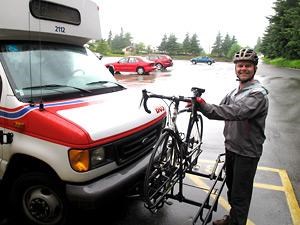Residents in the Powell River region have an opportunity to express their ideas about, and issues with, transportation.
Powell River Regional District is working with ISL Engineering and Land Services to develop a regional transportation plan, which will set out the long-term blueprint for transportation in the region.
The development of the plan includes a background review and stakeholder consultation, both of which are underway. The first round of public consultation will take place during the first and second weeks of July at four meetings in different areas of the region. During the sessions, participants will be asked about their issues with transportation and ideas to improve it. Another round of meetings will be held in the fall to discuss options that will be included in the plan.
The focus of the regional transportation plan is on the rural areas, said Laura Roddan, regional district manager of planning, and the interconnectedness among all of the rural areas, the City of Powell River and beyond, for example, Vancouver and Vancouver Island. The impetus for the study was the board’s strategic planning process for 2013, she added. “There has never been a regional transportation plan done for Powell River region,” she said. “We’re filling a gap there.”
The board’s vision was to pick up on the sustainability charter signed by the city, the regional district and Tla’amin (Sliammon) First Nation, Roddan explained. “Transportation is a regional issue that we need to be working collaboratively on,” she said. Each of the governments has appointed elected officials and staff to the working group, which is acting like a steering committee for the project, along with representatives from the ministry of transportation and infrastructure, BC Transit and BC Ferries.
Having the plan done will provide an opportunity to hear from the public on what their issues are, Roddan said, what they perceive to be the problems with transportation and what some of their ideas are for improving it. “A primary focus is looking at alternative modes of transport, looking at those active transportation routes,” she said.
The process involves reviewing land use, walking, cycling, transport by road, air and sea and general traffic issues.
Roy Symons, the consultant working on the plan, said the public consultation sessions are designed to review existing conditions. “We’ll also review the existing transport network as well,” he said. “What bus services are available, where do they go to, where are there bicycle facilities, where are there sidewalks, crosswalks, what air services, ferry services are available.”
The initial phases let the consultants appreciate existing conditions and understand the needs of stakeholders and the public and how they would like to see the region change. The following stages establish the vision, Symons said, how the region should progress. “That’s based on some of the feedback from the initial public consultation and discussion with stakeholders and key decision makers,” he said. “We’ll also review policy and the ability to change that and potential funding sources as well.”
The last two parts of the process are option development, followed by recommendations and an implementation plan.
BC Transit is starting its own service review this summer and the two processes will benefit from each other, Roddan said. BC Transit will be able to drill down into more detail from the regional transportation plan, she added, and representatives will have access to the region’s public consultation material and have the ability to have input on the questions being asked of the public. “I think those two are going to dovetail well,” she said.
The meeting schedule for the first round of public consultation is:
• Wednesday, July 3, Lang Bay Community Hall.
• Thursday, July 4, Powell River Recreation Complex.
• Tuesday, July 9, Gillies Bay Community Hall on Texada Island.
• Wednesday, July 10, Sliammon Salish Centre.
All meetings take place from 7 to 9 pm.
More information about the plan and an online survey are available by following the links on the regional district’s website.



